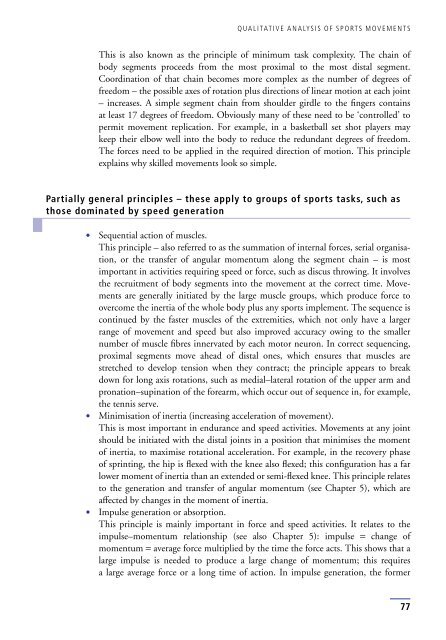Introduction to Sports Biomechanics: Analysing Human Movement ...
Introduction to Sports Biomechanics: Analysing Human Movement ...
Introduction to Sports Biomechanics: Analysing Human Movement ...
Create successful ePaper yourself
Turn your PDF publications into a flip-book with our unique Google optimized e-Paper software.
QUALITATIVE ANALYSIS OF SPORTS MOVEMENTS<br />
This is also known as the principle of minimum task complexity. The chain of<br />
body segments proceeds from the most proximal <strong>to</strong> the most distal segment.<br />
Coordination of that chain becomes more complex as the number of degrees of<br />
freedom – the possible axes of rotation plus directions of linear motion at each joint<br />
– increases. A simple segment chain from shoulder girdle <strong>to</strong> the fingers contains<br />
at least 17 degrees of freedom. Obviously many of these need <strong>to</strong> be ‘controlled’ <strong>to</strong><br />
permit movement replication. For example, in a basketball set shot players may<br />
keep their elbow well in<strong>to</strong> the body <strong>to</strong> reduce the redundant degrees of freedom.<br />
The forces need <strong>to</strong> be applied in the required direction of motion. This principle<br />
explains why skilled movements look so simple.<br />
Partially general principles – these apply <strong>to</strong> groups of sports tasks, such as<br />
those dominated by speed generation<br />
Sequential action of muscles.<br />
This principle – also referred <strong>to</strong> as the summation of internal forces, serial organisation,<br />
or the transfer of angular momentum along the segment chain – is most<br />
important in activities requiring speed or force, such as discus throwing. It involves<br />
the recruitment of body segments in<strong>to</strong> the movement at the correct time. <strong>Movement</strong>s<br />
are generally initiated by the large muscle groups, which produce force <strong>to</strong><br />
overcome the inertia of the whole body plus any sports implement. The sequence is<br />
continued by the faster muscles of the extremities, which not only have a larger<br />
range of movement and speed but also improved accuracy owing <strong>to</strong> the smaller<br />
number of muscle fibres innervated by each mo<strong>to</strong>r neuron. In correct sequencing,<br />
proximal segments move ahead of distal ones, which ensures that muscles are<br />
stretched <strong>to</strong> develop tension when they contract; the principle appears <strong>to</strong> break<br />
down for long axis rotations, such as medial–lateral rotation of the upper arm and<br />
pronation–supination of the forearm, which occur out of sequence in, for example,<br />
the tennis serve.<br />
Minimisation of inertia (increasing acceleration of movement).<br />
This is most important in endurance and speed activities. <strong>Movement</strong>s at any joint<br />
should be initiated with the distal joints in a position that minimises the moment<br />
of inertia, <strong>to</strong> maximise rotational acceleration. For example, in the recovery phase<br />
of sprinting, the hip is flexed with the knee also flexed; this configuration has a far<br />
lower moment of inertia than an extended or semi-flexed knee. This principle relates<br />
<strong>to</strong> the generation and transfer of angular momentum (see Chapter 5), which are<br />
affected by changes in the moment of inertia.<br />
Impulse generation or absorption.<br />
This principle is mainly important in force and speed activities. It relates <strong>to</strong> the<br />
impulse–momentum relationship (see also Chapter 5): impulse = change of<br />
momentum = average force multiplied by the time the force acts. This shows that a<br />
large impulse is needed <strong>to</strong> produce a large change of momentum; this requires<br />
a large average force or a long time of action. In impulse generation, the former<br />
77






